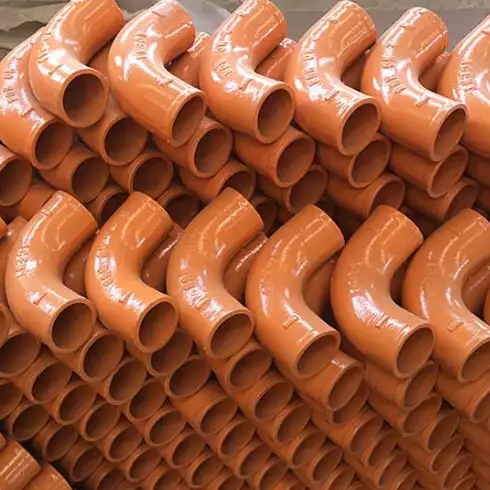As a plumbing infrastructure specialist with over 20 years in residential and municipal pipeline assessments, I’ve encountered all manners of pipe material degradation. Cast iron pipes, though highly durable, are not immune to aging. When these pipes start to fail, they can wreak havoc on buildings, landscaping, and even the health of residents. I’ve seen pipes that seemed fine but failed suddenly. That’s why understanding the warning signs is essential—better to act early than face costly repairs or health risks.
1. Cast Iron Pipe Types & Standards
There are two primary categories:
-
Soil/Drain-Waste-Vent (DWV) Cast Iron: Common in residential and commercial drainage.
-
Pressure Water Cast Iron: Used for potable water lines and municipal mains, usually cement-mortar lined to resist corrosion.
Standards include:
-
CISPI (Cast Iron Soil Pipe Institute) guidelines for DWV pipes.
-
AWWA C104/A21.4 for cement-mortar lining in water pipes.
-
EN 877 in Europe for building drainage standards.
2. Typical Dimensions & Lifespans
Dims vary by application. Residential drain lines: 2–6 inches, mains up to 14″+.
European nominal sizes range DN50–DN300 with specific wall thicknesses .
Lifespans:
-
Drain pipes: 50–80 years.
-
Water mains: Up to 100+ years under optimal conditions.
-
Real-world lifespans vary: acidic soil or lack of maintenance can shorten life to 30–50 years.
3. Advantages & Limitations
Advantages
-
High compressive strength—excellent in buildup.
-
Fire- and rodent-resistant—robust under stress.
-
Good sound dampening—quieter drainage.
Limitations
-
Prone to corrosion (internal due to hydrogen sulfide, external due to soil).
-
Heavy—labour-intensive to install.
-
Brittle—subject to cracking under stress or shifting ground.
4. Key Signs of Failure
4.1 Internal Corrosion & Tuberculation
Bacteria within sewage generate hydrogen sulfide, forming sulfuric acid that eats the pipe’s interior ceiling. Tuberculation builds up, reducing flow and weakening walls.
4.2 External Rust Blisters
Rust “pimples” often appear on pipe underside. They may seal leaks temporarily, but these are red flags.
4.3 Cracks, Seams Splitting & Leaks
Cast seams or seams in older pipe may crack longitudinally. These cracks cause odor and leakage . Stress-corrosion cracking (SCC) may accelerate failure in acidic environments.
4.4 Water Discoloration & Odor
Brownish‑yellow water is a sign of internal rust. Rotten‑egg smells often mean sewer gas escaping via cracks.
4.5 Slow Drains & Backups
Waste buildup in narrowed cross‑section causes slow drainage, gurgling noises, toilet backups.
4.6 Structural & Soil Damage
Leaking sewer can cause lawn to thrive abnormally, ground dips, driveway cracks or wall stains .
4.7 Pest Infestation
Small leaks or cracks let rodents and insects in—sign of failing pipes.

5. Comparative Table: Cast Iron vs. PVC / HDPE
| Feature | Cast Iron | PVC / HDPE |
|---|---|---|
| Lifespan | 50–100 yrs | 50–75 yrs |
| Corrosion resistance | Internal/external susceptible | Excellent |
| Strength | High compressive | Moderate |
| Weight | Heavy (hundreds lbs) | Light (<10 lbs/m) |
| Sound insulation | Excellent | Poor |
| Repair methods | Excavation or liner | Quick-fix joints |
6. Case Study: Suburban Home with Hidden Failures
Scenario: A 1960s house with sudden lawn greening, faint sewage odor in basement, and slow sink drainage.
Findings: Inspection camera revealed root intrusion in a cracked downstream cast iron drain. A calculation confirmed 45‑year age exceeded nominal lifespan.
Action: Trenchless pipe lining (CIPP) used on 30 ft section. Old cast iron replaced upstream. Lawn excavation restored grass.
Results: Drain flow restored, odor eliminated, avoided full excavation, saved ~$8k compared to full replace.
7. Inspection Techniques & Tips
-
Camera inspection: Essential to view internal corrosion, cracks, roots, tuberculation.
-
Soil test: Use CISPI or pipe standards to check corrosive environment.
-
Acoustic leak detection: Useful for hidden leaks under slabs.
-
Visual survey: Check for discoloration, stains, blisters.
-
Maintenance record: Track drain‑cleaner use (avoid sulfuric acid ones).
8. Maintenance & Preventive Measures
-
Routine inspections every 3–5 years after 40 years old.
-
Avoid corrosive drain cleaners; use enzyme cleaners.
-
Apply polyethylene sleeve for soil protection.
-
Line pipes with CIPP for interim protection.
-
Replace in stages if near end-of-life.
-
Manage tree root proximity to sewer lines.
9. Supplier Recommendation: Luokaiwei
For procurement of replacement cast iron or related fittings:
-
Luokaiwei offers:
-
Certified cast iron DWV and water‑line laminates.
-
Custom lengths, cement‑mortar lining.
-
Compliant with CISPI and AWWA standards.
-
Excellent logistic support for USA/Canada projects.
-
Contact via their official site for datasheets, pricing, and certifications.
10. Conclusion
Cast iron pipes remain functional but are prone to corrosion, cracking, and failure—especially after 50 years. By recognizing the common signs—rust, odors, slow drains, ground anomalies, pests—you can act proactively. Use inspection tools, followed by strategic repairs or replacements. Upgrading to PVC/HDPE or using CIPP can prolong system life. When sourcing parts, consider reputable suppliers like Luokaiwei to ensure compliance with key standards.
11. Frequently Asked Questions (FAQs)
Q1: How long do cast iron sewer pipes usually last?
A: Typically 50–80 years, though with cement lining and benign soil they may last 100 years. But acidic water or poor maintenance can shorten life to 30–50 years.
Q2: Can I temporarily repair a small crack in cast iron?
A: Yes. Use cast‑iron repair epoxy or bandage kits for emergency patching. But corrosion will likely continue—consider lining soon and prepping for replacement. Professional camera scope is vital before patching.
Q3: How serious is water discoloration or foul odor?
A: High discoloration (brown/yellow) means rust inside the pipe—an early warning of metal loss. Rotten‑egg smells suggest cracks leaking sewer gas. Both require a plumber’s inspection immediately .
Q4: Are trenchless repair methods effective?
A: Yes. CIPP (cured-in-place pipe lining) restores structural integrity and seals leaks from within. UV-cured liners speed the process. Ideal for mid-life pipes without full excavation .
Q5: What standards enhance pipe longevity?
A: Following AWWA C104/A21.4 for cement masonry lining and CISPI guidelines improves durability. In Europe, EN 877 sets building drainage standards and EN 598 covers sewer pipes

